
Kidney Treatment Options
You have the right to choose or to change to a different kidney treatment modality (option) that is best for you. It is your right to be fully informed of all treatment options available. Qsource ESRD Networks would like to provide you with information that can allow you to choose the modality that best meets your needs. Remember, the Networks are here for you, helping you stay an active participant in your treatment.
Learn more about kidney failure symptoms and causes and what dialysis does for your body.
Vascular Access & Dialysis
Dialysis is a treatment that does some of the things done by healthy kidneys. Your hemodialysis access, or vascular access, is a way to reach your blood for hemodialysis treatments. It is needed when your own kidneys can no longer take care of your body’s needs. Minor surgery is needed to place a vascular access. The 3 types of vascular accesses are called a fistula, graft, and a catheter. The access allows your blood to travel through soft tubes to the dialysis machine where it is cleaned as it passes through a special filter, called a dialyzer. Download What You Need to Know About Vascular Access to learn more.
In-Center Hemodialysis
ICHD uses a vascular access. Trained staff is available for care in the dialysis clinic. Treatments are scheduled usually three times a week for three to five hours each treatment at a facility. You will be seen by a nephrologist regularly at the dialysis clinic.
Home Dialysis
You can do your dialysis treatments at home! When you do dialysis at home you can do it on your own schedule. When you start home dialysis, you will be trained at the clinic. After you have completed training, dialysis staff will meet with you regularly to monitor your treatments and labs. You will need to come back to the clinic to be seen by a nephrologist routinely, and telehealth is also an option in most clinics.
Home Hemodialysis (HHD)
You will need a vascular access placed, a fistula or graft. Your treatment times can be 3-4 times a week for 3-4 hours at a time, every other night for 7-8 hours while you sleep (nocturnal home hemodialysis), or 2-3 hour treatments 5-6 times a week.
Peritoneal Dialysis (PD)
PD is a home dialysis treatment which removes waste and excess fluid by using the peritoneum (a thin lining) in your abdomen to act as a filter. A permanent PD catheter is placed in the abdomen. PD fluid flows into the peritoneum through the catheter. The fluid helps filter out waste products. After a set period of time (three to four hours) the fluid is drained and discarded. Fresh fluid is then infused, and the process begins again. This filling and draining process is called an exchange.
- Continuous Ambulatory Peritoneal Dialysis (CAPD) happens with 4 or more manual exchanges in 24 hours.
- Continuous Cycling Peritoneal Dialysis (CCPD) uses a machine for 6-10 hours while you sleep every night.
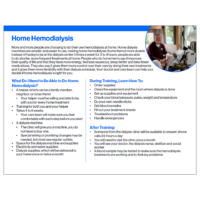
Download: Home Hemodialysis Handout
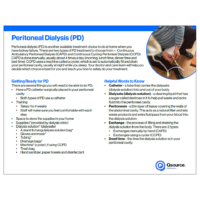
Download: Peritoneal Dialysis
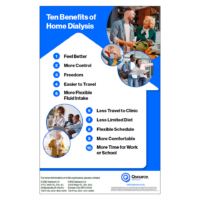
Download: Ten Benefits of Home Dialysis
Kidney Transplant
A kidney transplant is when a healthy kidney is placed inside your body, through surgery, to do the work that your kidneys can no longer do. There are two types of donors, a deceased donor and a living donor.
- Deceased Donor: These kidneys come from someone who died and was on the donor list.
- Living Donor: These kidneys come from a living person, usually a family member or friend, but may also be a stranger. If there is someone who wants to donate a kidney to someone but is not a match they can be a part of the paired exchange program.
Transplant centers will work with patients through the evaluation process to decide if a transplant is right for them. A person is then paced on a wait list. The wait time for a kidney transplant varies, but finding a living donor usually is a faster way to get a transplant. Once someone receives a kidney transplant, they will need to take medication every day for life. Learn more about kidney transplant here.
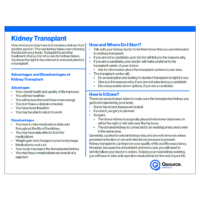
Download: Kidney Transplant Patient Handout
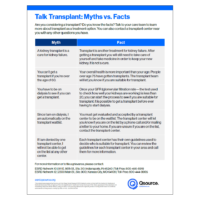
Download: Talk Transplant – Myths vs Facts
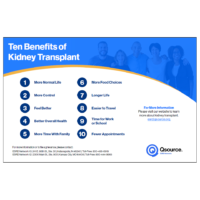
Download: Ten Benefits of Kidney Transplant





